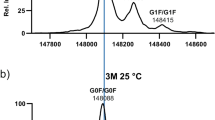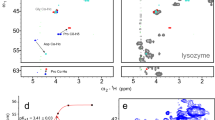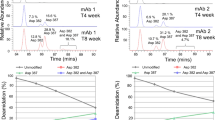Abstract
Isomerization of aspartic acid (Asp) in therapeutic proteins could lead to safety and efficacy concerns. Thus, accurate quantitation of various Asp isomerization along with kinetic understanding of the variant formations is needed to ensure optimal process development and sufficient product quality control. In this study, we first observed Asp-succinimide conversion in complementarity-determining regions (CDRs) Asp-Gly motif of a recombinant mAb through ion exchange chromatography, intact protein analysis by mass spectrometry, and LC-MS/MS. Then, we developed a specific peptide mapping method, with optimized sample digestion conditions, to accurately quantitate Asp-succinimide-isoAsp variants at peptide level without method-induced isomerization. Various kinetics of Asp-succinimide-isoAsp isomerization pathways were elucidated using 18O labeling followed by LC-MS analysis. Molecular modeling and molecular dynamic simulation provide additional insight on the kinetics of Asp-succinimide formation and stability of succinimide intermediate. Findings of this work shed light on the molecular construct and the kinetics of the formation of isoAsp and succinimide in peptides and proteins, which facilitates analytical method development, protein engineering, and late phase development for commercialization of therapeutic proteins.








Similar content being viewed by others
References
Clarke S. Propensity for spontaneous succinimide formation from aspartyl and asparaginyl residues in cellular proteins. Chem Biol Drug Des. 1987;30:808–21.
Ritz-Timme S, Collins MJ. Racemization of aspartic acid in human proteins. Ageing Res Rev. 2002;1:43–59.
Geiger T, Clarke S. Deamidation, isomerization, and racemization at asparaginyl and aspartyl residues in peptides. Succinimide-linked reactions that contribute to protein degradation. J Biol Chem. 1987;262:785–94.
Lindner H, Helliger W. Age-dependent deamidation of asparagine residues in proteins. Exp Gerontol. 2001;36:1551–63.
Voorter CE, de Haard-Hoekman WA, van den Oetelaar PJ, Bloemendal H, de Jong WW. Spontaneous peptide bond cleavage in aging alpha-crystallin through a succinimide intermediate. J Biol Chem. 1988;263:19020–3.
Tomiyama T, Asano S, Furiya Y, Shirasawa T, Endo N, Mori H. Racemization of Asp23 residue affects the aggregation properties of Alzheimer amyloid β protein analogues. J Biol Chem. 1994;269:10205–8.
Garner WH, Spector A. Racemization in human lens: evidence of rapid insolubilization of specific polypeptides in cataract formation. Proc Natl Acad Sci. 1978;75:3618–20.
Ahern TJ, Klibanov AM. The mechanisms of irreversible enzyme inactivation at 100C. Science. 1985;228:1280–4.
Cacia J, Keck R, Presta LG, Frenz J. Isomerization of an aspartic acid residue in the complementarity-determining regions of a recombinant antibody to human IgE: identification and effect on binding affinity. Biochemistry. 1996;35:1897–903.
Doyle HA, Gee RJ, Marmula MJ. Altered immunogenicity of isoaspartate containing proteins. Autoimmunity. 2007;40:131–7.
Wakankar AA, Borchardt RT, Eigenbrot C, Shia S, Wang YJ, Shire SJ, et al. Aspartate isomerization in the complementarity-determining regions of two closely related monoclonal antibodies. Biochemistry. 2007;46:1534–44.
Yang X, Xu W, Dukleska S, Benchaar S, Mengisen S, Antochshuk V, et al. Developability studies before initiation of process development: improving manufacturability of monoclonal antibodies. MAbs. 2013;5:787–94.
Dick LW Jr, Qiu D, Cheng KC. Identification and measurement of isoaspartic acid formation in the complementarity determining region of a fully human monoclonal antibody. J Chromatogr B. 2009;877:3841–9.
Yan Y, Wei H, Fu Y, Jusuf S, Zeng M, Ludwig R, et al. Isomerization and oxidation in the complementarity-determining regions of a monoclonal antibody: a study of the modification−structure−function correlations by hydrogen−deuterium exchange mass spectrometry. Anal Chem. 2016;88:2041–50.
Yan Q, Huang M, Lewis MJ, Hu P. Structure based prediction of asparagine Deamidation propensity in monoclonal antibodies. Mabs. 2018;10:901–12.
Robinson NE, Robinson AB. Molecular Clocks. Proc Natl Acad Sci U S A. 2001;98:944–9.
Xie M, Schowen RL. Secondary structure and protein deamidation. J Pharm Sci. 1999;88:8–13.
Kosky AA, Razzaq UO, Treuheit MJ, Brems DN. The effects of alpha-helix on the stability of Asn residues: deamidation rates in peptides of varying helicity. Protein Sci. 1999;8:2519–23.
Sydow JF, Lipsmeier F, Larraillet V, Hilger M, Mautz B, Mølhøj M, et al. Structure-based prediction of asparagine and aspartate degradation sites in antibody variable regions. PLoS One. 2014;9:e100736.
Chu GC, Chelius D, Xiao G, Khor HK, Coulibaly S, Bondarenko PV. Accumulation of Succinimide in a recombinant monoclonal antibody in mildly acidic buffers under elevated temperatures. Pharm Res. 2007;24:1145–56.
Brennan TV, Clarke S. Spontaneous degradation of polypeptides at aspartyl and asparaginyl residues: effects of the solvent dielectric. Protein Sci. 1993;2:331–8.
Lu X, Nobrega RP, Lynaugh H, Jain T, Barlow K, Boland T, et al. Deamidation and isomerization liability analysis of 131 clinical-stage antibodies. MAbs. 2019;11:45–57.
Wakankar AA, Borchardt RT. Formulation considerations for proteins susceptible to asparagine deamidation and aspartate isomerization. J Pharm Sci. 2006;95:2321–36.
Mehl JT, Sleczka BG, Ciccimaro EF, Kozhich AT, Gilbertson DG, Vuppugalla R, et al. Quantification of in vivo site-specific asp isomerization and Asn deamidation of mAbs in animal serum using IP-LC–MS. Bioanalysis. 2016;8:1611–22.
Harris RJ, Kabakoff B, Macchi FD, Shen FJ, Kwong M, Andya JD, et al. Identification of multiple sources of charge heterogeneity in a recombinant antibody. J Chromatogr B. 2001;752:233–45.
Du Y, Walsh A, Ehrick R, Xu W, May K, Liu H. Chromatographic analysis of the acidic and basic species of recombinant monoclonal antibodies. MAbs. 2012;4:578–85.
Valliere-Douglass J, Jones L, Shpektor D, Kodama P, Wallace A, Balland A, et al. Separation and characterization of an IgG2 antibody containing a cyclic imide in CDR1 of light chain by hydrophobic interaction chromatography and mass spectrometry. Anal Chem. 2008;80:3168–74.
Hsiao K, Alves J, Patel R, Adams M, Nashine V, Goueli SA. High-throughput bioluminescent assay to monitor the Deamidation of asparagine and isomerization of aspartate residues in therapeutic proteins and antibodies. J Pharm Sci. 2017;106:1528–37.
Fujii N, Takata T, Fujii N, Aki K. Isomerization of aspartyl residues in crystallin and its influence upon cataract. Biochim Biophys Acta. 1860;2016:183–91.
Bai L, Romanova EV, Sweedler JV. Distinguishing endogenous D-amino acid-containing neuropeptides in individual neurons using tandem mass spectrometry. Anal Chem. 2011;83:2794–800.
Adams CM, Zubarev RA. Distinguishing and quantifying peptides and proteins containing D-amino acids by tandem mass spectrometry. Anal Chem. 2005;77:4571–80.
Serafin SV, Maranan R, Zhang KL, Morton TH. Mass spectrometric differentiation of linear peptides composed of L-amino acids from isomers containing one D-amino acid residue. Anal Chem. 2005;77:5480–7.
Sachon E, Clodic G, Galanth C, Amiche M, Ollivaux C, Soyez D, et al. D-amino acid detection in peptides by MALDI-TOF-TOF. Anal Chem. 2009;81:4389–96.
Tao Y, Quebbemann NR, Julian RR. Discriminating D-amino acid-containing peptide Epimers by radical-directed dissociation mass spectrometry. Anal Chem. 2012;84:6814–20.
Hurtado PP, O’Connor PB. Differentiation of isomeric amino acid residues in proteins and peptides using mass spectrometry. Mass Spectrom Rev. 2012;31:609–25.
Cournoyer JJ, Pittman JL, Ivleva VB, Fallows E, Waskell L, Costello CE, et al. Deamidation: differentiation of aspartyl from isoaspartyl products in peptides by electron capture dissociation. Protein Sci. 2005;14:452–63.
Jia C, Lietz CB, Yu Q, Li L. Site-specific characterization of D-amino acid containing peptide Epimers by ion mobility spectrometry. Anal Chem. 2014;86:2972–81.
Zheng X, Deng L, Baker ES, Ibrahim YM, Petyuk VA, Smith RD. Distinguishing D- and L-aspartic and isoaspartic acids in amyloid b peptides with ultrahigh resolution ion mobility spectrometry. Chem Commun. 2017;53:7913–6.
Capasso S, Mazzarella L, Sica F, Zagari A, Salvadori S. Kinetics and mechanism of Succinimide ring formation in the Deamidation process of asparagine residues. J Chem Soc Perkin Trans 2. 1993;4:679–782.
Cao M, Mulagapati SHR, Vemulapalli B, Wang J, Saveliev SV, Urh M, et al. Characterization and quantification of succinimide using peptide mapping under low-pH conditions and hydrophobic interaction chromatography. Anal Biochem. 2019;566:151–9.
Nowak C, Ponniah G, Neill A, Liu H. Characterization of succinimide stability during trypsin digestion for LC-MS analysis. Anal Biochem. 2017;526:1–8.
Liu S, Moulton KR, Auclair JR, Zhou ZS. Mildly acidic conditions eliminate deamidation artifact during proteolysis: digestion with endoprotease Glu-C at pH 4.5. Amino Acids. 2016;48:1059–67.
Klaene JJ, Ni W, Alfaro JF, Zhou ZS. Detection and quantitation of succinimide in intact protein via hydrazine trapping and chemical derivatization. J Pharm Sci. 2014;103:3033–42.
Ni W, Dai S, Karger BL, Zhou ZS. Analysis of isoaspartic acid by selective proteolysis with asp-N and electron transfer dissociation mass spectrometry. Anal Chem. 2010;82:7485–91.
Yu XC, Joe K, Zhang Y, Adriano A, Wang Y, Gazzano-Santoro H, et al. Accurate determination of succinimide degradation products using high fidelity trypsin digestion peptide map analysis. Anal Chem. 2011;83:5912–9.
Connolly BD, Tran B, Moore JMR, Sharma VK, Kosky A. Specific catalysis of Asparaginyl Deamidation by carboxylic acids: kinetic, thermodynamic, and quantitative structure−property relationship analyses. Mol Pharma. 2014;11:1345–−1358.
Ionescu R, Vlasak J. Kinetics of chemical degradation in monoclonal antibodies: relationship between rates at the molecular and peptide levels. Anal Chem. 2010;82:3198–206.
Eswar N, Webb B, Marti-Renom MA, Madhusudhan MS, Eramian D, Shen MY, et al. Comparative protein structure modeling using Modeller Curr Protoc Curr. Protoc. Bioinformatics. 2006;5 Unit–5.6.
Fujii N, Sakaue H, Sasaki H, Fujii N. A rapid, comprehensive liquid chromatography-mass spectrometry (LC-MS)-based survey of the asp isomers in Crystallins from human cataract lenses. J Biol Chem. 2012;287:399992–400002.
Maedo H, Takata T, Fujii N, Sakaue H, Nirasawa S, Takahashi S, et al. Rapid survey of four asp isomers in disease-related proteins by LCMS combined with commercial enzymes. Anal Chem. 2015;87:561–8.
Capasso S. Thermodynamic parameters of the reversible isomerization of aspartic residues via a succinimide derivative. Thermochim Acta. 1996;286:41–50.
Riggs D, Gomez SV, Julian RR. Sequence and solution effects on the prevalence of D-isomers produced by Deamidation. ACS Chem Biol. 2017;12:2875–82.
Oliyai C, Borchardt RT. Chemical pathways of peptide degradation. IV. Pathways, kinetics, and mechanism of degradation of an aspartyl residue in a model hexapeptide. Pharm Res. 1993;10:95–102.
Lindquist JA, McFadden PN. Incorporation of two 18O atoms into a peptide during isoaspartyl repair reveals repeated passage through a succinimide intermediate. J Protein Chem. 1994;13:553–60.
Terashima I, Koga A, Nagai H. Identification of deamidation and isomerization sites on pharmaceutical recombinant antibody using H218O. Anal Biochem. 2007;368:49–60.
Wang S, Kaltashov IA. An 18O‑labeling assisted LC/MS method for assignment of aspartyl/Isoaspartyl products from Asn Deamidation and asp isomerization in proteins. Anal Chem. 2013;85:6446–52.
Xiao G, Bondarenko PV, Jacob J, Chu GC, Chelius D. 18O labeling method for identification and quantification of Succinimide in proteins. Anal Chem. 2007;79:2714–21.
Yao X, Freas A, Ramirez J, Demirev PA, Fenselau C. Proteolytic 18O labeling for comparative proteomics: model studies with two serotypes of adenovirus. Anal Chem. 2001;73:2836–42.
Schnölzer M, Jedrzejewski P, Lehmann WD. Protease-catalyzed incorporation of 18O into peptide fragments and its application for protein sequencing by electrospray and matrix-assisted laser desorption/ionization mass spectrometry. Electrophoresis. 1996;17:945–53.
Clarke S. Propensity for spontaneous Succinimide formation from aspartyl and Asparaginyl residues in cellular proteins. Int J Peptide Protein Res. 1987;30:808–21.
Acknowledgements
The authors would like to acknowledge Dr. Jeff Beckman for his critical review and Drs. Jing Tong, Kai Meng Zhou, and Li Tao for their scientific input. The authors also would like to thank Suzanne Shirar for her assistance in manuscript preparation. Yuanli Song would like to thank Dr. Jie Chen for her administrative support.
Author information
Authors and Affiliations
Corresponding author
Ethics declarations
Competing interests
The authors declare no competing interests.
Additional information
Publisher’s note
Springer Nature remains neutral with regard to jurisdictional claims in published maps and institutional affiliations.
Supplementary information
ESM 1
(DOCX 884 kb)
Rights and permissions
About this article
Cite this article
Kuang, J., Tao, Y., Song, Y. et al. Understanding the pathway and kinetics of aspartic acid isomerization in peptide mapping methods for monoclonal antibodies. Anal Bioanal Chem 413, 2113–2123 (2021). https://doi.org/10.1007/s00216-021-03176-z
Received:
Revised:
Accepted:
Published:
Issue Date:
DOI: https://doi.org/10.1007/s00216-021-03176-z




